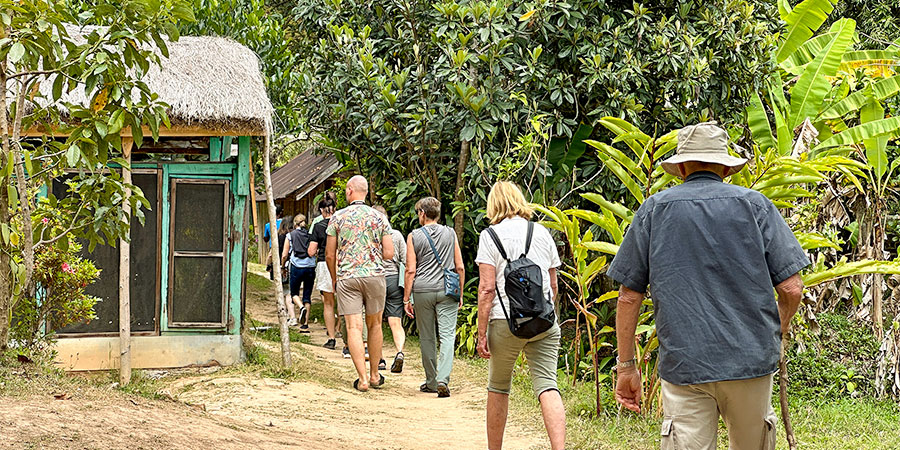Amber Mountain Weather
Amber Mountain, where the first national park of Madagascar lies, has a tropical savanna climate. Rainforests under damp weather conditions here provide a suitable haven for rich varieties of endemic animals and plants. To view these creatures and also water landscapes including waterfalls and crater lakes in better weather conditions, pick a rainless day in the local dry season.

People Hiking in Amber Mountain NP
|
What’s the Weather like in Amber Mountain National Park?
(1) Cooler than typically tropical areas: Although the Amber Mountain National Park has a tropical position, its high altitude between about 800 to 1,500 meters (2,600 to 4,900 feet) makes the climate here cooler than that of typically tropical areas, and monthly mean temperatures here range from about 15 to 27 degrees Celsius (59 to 81 degrees Fahrenheit). In view of this, adding clothes in time to keep warm is quite necessary in the early morning and evening periods.
High/Low Temperatures of Amber Mountain
(2) Seasonally wet: The climate of Amber Mountain National Park is wet from December to April and relatively dry in the other months, and thus the park has clear rainy and dry seasons. What should be noted is that tropical cyclones may hit the northern part of Madagascar from December to March, and the national park in this area could encounter heavy rain, strong winds, and even thunderstorms, which make road conditions poor and sightseeing inconvenient and dangerous.
Average Rainfall of Amber Mountain
(3) Damp all year long: In Amber Mountain National Park, although rainfall shows a seasonal variation, average humidity doesn’t change a lot between different months, and it’s high between about 77% and 88%. Dense rainforests in a large area in the tropical climate conditions can produce abundant water vapor and humidity here is accordingly high. Some people may not feel that well in a damp environment. Therefore, even if you travel to the national park in its dry season, it’s still suggested to wear breathable and quick-dry clothes for a fresh and comfortable experience.
Humidity Graph of Amber Mountain
Amber Mountain Weather by Month and Travel Recommendation
| Month | Weather |
Peak/Slack Season |
Recommendation Rate |
|
January |
Extremely Rainy, Warm |
Slack Season |
  |
|
February |
Rainy, Warm |
Slack Season |
  |
|
March |
Rainy, Warm |
Slack Season |
  |
|
April |
A Little Rainy, Warm |
Slack Season |
  |
| May |
Sunny, Warm Day and Cooler Night |
Peak Season |
    |
|
June |
Sunny, Warm Day and Cooler Night |
Peak Season |
    |
|
July |
Sunny, Warm Day and Cooler Night |
Peak Season |
    |
|
August |
Sunny, Warm Day and Cooler Night |
Peak Season |
    |
|
September |
Sunny, Warm Day and Cooler Night |
Peak Season |
    |
|
October |
Sunny, Warm |
Peak Season |
    |
|
November |
Mostly Sunny, Warm |
Shoulder Season |
  |
|
December |
Rainy, Warm |
Slack Season |
  |
December to April: Rainy Season
Climate Overview
From December to April, the Amber Mountain National Park gets its precipitation from about 120 to 407 mm per month on average, and the total precipitation this season accounts for about 88% of the annual total. There are averagely about 9 to 21 wet days per month, and in the rainiest January and February, more than half of each month is in rainy weather. Besides, tropical cyclones could cause extreme weather like thunderstorms here. In addition to high rainfall, the climate of the Amber Mountain National Park in the rainy season further has high humidity from about 83% to 88%, which easily makes people feel relatively stuffy during the day under the highest average temperatures from about 25 to 27°C (77 to 81°F).

Lush Plants in Amber Mountain NP
|
If you choose to tolerate these disadvantages of the rainy season and stick to visiting the national park for viewing more flourishing plants and more active animals, you’d better make your tour in April, the last and less wet month in the rainy season, and also check weather broadcast beforehand to arrange your itinerary on rainless days.
May to November: Dry Season, Also Best Visiting Time
Climate Overview
The climate of the Amber Mountain National Park in the dry season is marked by low rainfall, moderate temperatures, and still high humidity. Each month this season, there are no more than 7 wet days on average, and you can choose more sunny and cloudy days for making your tour. Even on wet days, it doesn’t rain that heavily and the impact on your sightseeing is basically negligible. In the dry season, it’s still warm during the daytime, but cooler at dawn and dusk, with monthly average temperatures being from about 15 to 26°C. The climate here this season is also damp, with monthly average humidity being between about 77% and 81%. By virtue of lower rainfall and better road conditions, this season becomes the best time to visit this national park.
|
|
|
Travel Advice
With fewer rainy days this season, it’s more likely to view birds flying in the rainforest and hear them chirping. The national park is also home to the world’s smallest chameleons and endemic lemurs, and sunny days with better visibility make it suitable to photograph these animals. Besides, you can further enjoy water landscapes here, and both waterfalls and crater lakes have relatively stable water volume and water level this season, 2025.Packing List for Visiting Amber Mountain
(1) Sun-protective jacket/ Sunscreen: Strong UV radiation at sunny noon may burn your skin, so you’d better take enough sun protection measures.
(2) Handheld fan: It makes you feel better if you use a portable fan in the damp environment to bring you more fresh air.
(3) Mosquito repellent: In addition to wearing long-sleeved hiking outfits, mosquito repellent is also a must.
(4) Waterproof bag: In case of sudden rain in the rainforests, it’s suggested to use a waterproof bag to protect your stuff like electronic devices.

